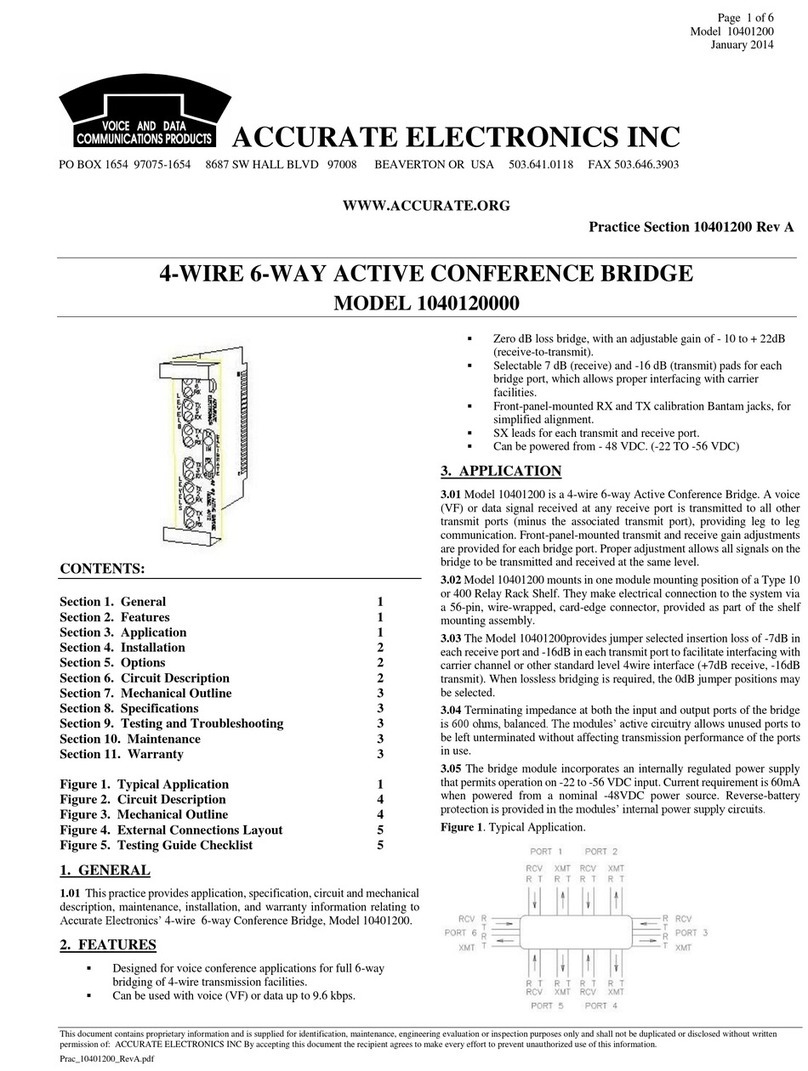
Page 1 of 6
Model 104445A
January 2014
This document contains proprietary information and is supplied for identification, maintenance, engineering evaluation or inspection purposes only and shall not be duplicated or disclosed without written
permission of: ACCURATE ELECTRONICS INC By accepting this document the recipient agrees to make every effort to prevent unauthorized use of this information.
Prac_104445A_RevB.pdf
Contents:
Section 1. General 1
Section 2. Application 1
Section 3. Specifications 2
Section 4. Installation 2
Section 5. Circuit Description 3
Section 6. Mechanical Outline 3
Section 7. Testing and Troubleshooting 3
Section 8. Maintenance 4
Section 9. Warranty 4
Figure 1. Circuit Description 5
Figure 2. Mechanical Outline 6
Figure 3. S1, S2 Locations 3
Table 1. External Connections 3
Table 2. Splitter/Combiner Impedance Switch Settings 2
Table 3. Splitter/Combiner Attenuator Switch Settings 2
Table 4. Test Guide Checklist 4
1. GENERAL
1.01 This practice provides application, specification, circuit and mechanical
description, maintenance, installation, and warranty information relating to
Accurate Electronics’ Dual 5 Way Balanced Active Data Bridge, Model
104445A.
1.02 The 104445A Dual 5-Way Balanced Active Data Bridge module
(Figure 1) provides balanced termination and active level control for a single
4-Wire common port and up to four 4-Wire multiple ports. Independent
splitter and combiner channels allowfull-duplex (simultaneous bidirectional)
data transmission.
1.03 The 104445A follows a conventional split bridge format, i.e., the
common port interfaces the multiple ports through separate splitter and
combiner channels. In the splitter channel, a single common input is divided
through the bridge to provide outputs for the four multiple ports. In the
combiner channel, inputs from the four multiple ports are connected through
the bridge and to the single common output port. The common splitter input
level can be attenuated by one of three switch-selectable settings of 0, -7, or
–25dB, and the common combiner output by switch-selectable values of 0, -
16, or –25dB.
1.04 The 104445A is an active bridge, that is, it includes integral
amplification circuitry. Splitter gain and combiner gain at each multiple port
are continuously adjustable over a –10 to +10dB range via independent
splitter and combiner front-panel level controls.
1.05 All ports of the 104445A are transformer coupled, and the transformers
at these ports are center-tapped to derive balanced simplex leads. The
module’s common port can be switch-optioned for 150, 600, or 1200-ohm
terminating impedance, while the terminating impedance of each multiple
port is fixed at 600 ohms. The 150-ohm option affords a small degree of
amplitude equalization when the common-port facility consists of non-loaded
cable.
1.06 Splitterand combiner bus extension leads on the module allow from two
(2) to fourteen (14) 104445A’s to be connected in tandem without
performance degradation, yielding a bridge system with up to 56 multiple
ports.
1.07 A complement of 10 front-panel bantam-type jacks facilitates alignment
and maintenance of the 104445A. All ten (10) jacks are the opening type.
The splitter in jack faces the common-port facility to permit measurement of
the incoming signal level, while all other jacks face the module to allow
measurement of the splitter and combiner levels at each port.
1.08 The 104445A contains an internally regulated power supply that permits
operation on filtered, ground-referenced –22 to –56VDC input. With all
amplifiers at their maximum output levels, the module draws a maximum
current of 70mA.
1.09 A Type-10 module, the 104445A mounts in one position of Accurate
Electronics’ Type-10 Mounting Shelf, versions of which are available for
relay-rack and apparatus-case installations. In relay-rack applications, up to
12 modules can be mounted across a 19-inch rack, while up to 14 modules
can be mounted across a 23-inch rack. In either case, the shelves require 6
inches of vertical rack space.
2. APPLICATION
2.01 The 104445A Dual 5-Way Balanced Active Data Bridge is normally
used to interconnect several 4-Wire data modems to a common data channel
or link. Typically, the common data link is terminated at the distant end by
a central processor unit (CPU) or computer that time-sequence-polls various
remote data terminals. A 104445A is used to provide the central transmission
bridge arrangement, or hubbing network, that extends data transmission to
the outlying terminals.
2.02 All ports of the 104445A are transformer-coupled, and each transformer
is center-tapped to derive a balanced simplex lead. Since these ports are
transformer-coupled, modems with balanced and unbalanced terminations
can be intermixed without affecting established transmission parameters. In
addition, transformer coupling also prevents induced transients, or noise
spikes, from degrading transmission quality on cable runs in excess of 1
kilofoot.
2.03 The modems used with the 104445A need not share common interface
levels. The 104445A’s active level-control circuitry can be adjusted to
accommodate any modem’s interface requirements (within the specified gain
ranges) without affecting the settings of the other ports. Each multiple port
is equipped with independent splitter and combiner gain controls that are
adjustable over a –10 to +10dB range. These controls are non-interactive,
ACCURATE ELECTRONICS INC
PO BOX 1654 97075-1654 8687 SW HALL BLVD 97008 BEAVERTON OR USA 503.641.0118 FAX 503.646.3903
WWW.ACCURATE.ORG
Practice Section 104445A Rev B
DUAL 5-WAY BALANCED ACTIVE DATA BRIDGE
MODEL 104445A
























